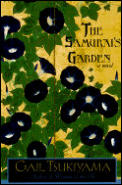 Gail Tsukiyama is a local writer of some note (dividing time between Napa and El Cerrito, a graduate of SF State.), and I’d never heard of her. Shame and pleasure. A shame to wait this long to discover her, a pleasure to find her at last.
Gail Tsukiyama is a local writer of some note (dividing time between Napa and El Cerrito, a graduate of SF State.), and I’d never heard of her. Shame and pleasure. A shame to wait this long to discover her, a pleasure to find her at last.
The Samurai’s Garden goes this way:
It’s 1937. Sixteen-year-old boy, Stephen, sickly and tubercular, travels from his mother’s house in Hong Kong to Kobe, Japan, where his father (also Chinese) has a business. His parents believe the drier climate might help his disease. From there, he goes to the family’s seaside cottage in a village some distance from the city.
Japanese armies are invading China, having just reached Shanghai. Hong Kong is a British protectorate, but the situation is deteriorating, and no one knows what might happen as the invaders sweep south.
The cottage is a strange place compared to Hong Kong. No lights, no noise except the distant surf, almost no people. The cottage caretaker is a man named Matsu, who has served the family for decades. He is as quiet as the environment. Stephen’s attempts at conversation come to almost nothing. When Stephen questions his father about Matsu, he hears that Matsu never reveals himself, prefers to be left alone, and that no one in the family knows anything about him. You might think this doesn’t sound like a setup for much of a novel, but you’d be fooled.
Stephen paints, journals, swims. A life as spare as a Japanese charcoal sketch, as simple as Tsukiyama’s language.
[I tried to go back to sleep,] but the sound of whispering voices grew louder. I sat up to see two shadows moving around on the other side of the fence. I tried to make out what was being said, but hey spoke in hushed, hurried tones. I was about to get up when I felt something brush the top of my head. I looked up to see a shower of white petals fall in my direction, scattering on the ground around me, dropping like little boats into the pond. I jumped up and could hear two girls laughing aloud as I rushed to the gate.
Each sentence a separate brush stroke, and there’s seldom a complex sentence in the whole novel. Gradually, however, the brush strokes build into an intricate design.
It turns out that Matsu is a man of many layers of experience and philosophy. His seemingly straightforward and uncomplicated life has actually been tortuous, and the twists and turns don’t stop during Stephen’s one-year stay. I won’t detail them here. You need to read them for yourself.
In addition to his relationship with Matsu, Stephen develops a romance of his own, carried out over months, much in the manner of the old courtly love tradition. The incident with the petals is one element in the process.. In addition, he becomes party to complications in the life of his parents. By the end of the year and the end of the novel, when he is forced to return to Hong Kong under the cloud of war, a time when foreigners like him will most likely be in danger in Japan, Stephen has regained physical health and grown emotionally. His future, though, is anything but certain with both his country and his parents’ marriage in peril.
And what of the garden? Matsu keeps one, of course, as does Sachi, another of the book’s main characters. And the gardens become metaphors for the transitory nature of our lives as well as for their constant renewal. Not a new idea, but Tsukiyama doesn’t whack us over the head with it. It’s organic to the book, so if you weren’t thinking about it, it might not occur to you. Still, you’d experience how central the gardens are to the unity of the tale.
It’s a disturbing and satisfying book, is The Samuri’s Garden. I’ll be happy to read more of Gail Tsukiyama. 